Laser 2
By John Turnbull
It’s the boat everyone seems to want. A two-person Laser with spinnaker and trapeze. “Best seller” is written all over it.
Success can be limiting. In showbiz it’s called typecasting. The actor who played Mr. Spock (Leonard Nimoy) is having a rough time holding down other roles without his audience wondering why they rounded off his ears. Performance Sailcraft of Montreal can’t sell a new sailboat without people wondering why it isn’t a Laser.
They tried. For the past four years they’ve been building the Tasar and for the past four years they’ve been answering the question, “Is this a two-person Laser?” The answer is no. Believe me, I own a Tasar and the only similarity to a Laser is in the rhyming of the name.
Tired of performing a routine few buyers seem to respond to, Performance decided to listen to what the crowd was saying. The new act is Laser 2. Entertainment for the whole family. If you enjoyed Laser you’re gonna love Laser 2.
Yes, it is a two-person Laser. It’s got a spinnaker, and a trapeze. You’ll go fast and get wet. It’s for sailors of all ages. And this is hard for an aficionado of the subtle and ingenious Tasar to admit, but the Laser 2, apart from promising
sure-fire success worldwide, is also a damn good boat.
Jay Cross, Olympic 470 forward hand, agreed to help me test-sail the Laser, though he’s accustomed to a higher
quality of helmsmanship. Angus Sailcraft of Toronto set us up with a boat and we took advantage of one of those sunny, blustery October days when our harbour was ruffled but hadn’t built any serious wave action. We left the sheltered quay at a trot, busily trying to familiarize ourselves with the gear. This is the kind of boat that is best sailed by instinct.
Once clear of the quay we were up to near-planing speed, on the wind. Any boat of this small size and light weight will reach its top displacing speed easily and start asking to plane. With Jay on the wire and once my steering settled down we did get a variable slow plane upwind without getting a really crisp break except in the gusts of about 18 knots. The helm (if you’ll permit me a comparison to the Tasar) seemed heavy, which is explained by its being swept back. The idea is to give it some feel for less experienced crew.
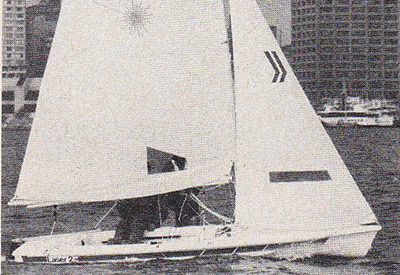 Bow sections are narrower than the Laser’s, so there’s more bite steering into a wave, but as the freeboard is low and the mid and aft sections wide and flat, the Laser 2 doesn’t have the upwind 68 Canadian Yachting ease and grace that are characteristic of other, possibly slower, designs.
Bow sections are narrower than the Laser’s, so there’s more bite steering into a wave, but as the freeboard is low and the mid and aft sections wide and flat, the Laser 2 doesn’t have the upwind 68 Canadian Yachting ease and grace that are characteristic of other, possibly slower, designs.
Other minor shortcomings show up too. I found the mainsheet fittings awkwardly placed, and the Laser traveler bridle – a simple effective solution on a single-hand boat – is just not adequate for the kind of mainsail trimming that should be done with a person on a trapeze. Traveler adjustments are difficult to make under load and the Clamcleat chosen was not big enough, or set on the correct angle, to grip the control line.
At 2:1, like a Laser, the mainsheet g purchase seems heavy. Off the wind, there’s nothing to it and you want quick response. But upwind, considering that the shaping controls, the vang, traveler and outhaul, are not easily adjusted, the mainsheet could be easier to handle. I’m of only average strength and I wasn’t able to do as much one-arm quick trimming as was needed to keep Jay off the water while he was traipsing. For younger, lighter helmsmen it would be too heavy to be fun on the long beats.
Trapeze gear is basic, with a handle but no adjustable hook height. Jay felt this was a crucial omission because it makes effective trapeze work, especially in marginal conditions, very difficult. He was able to lift himself up on the handle; normally, he would have shortened the wire. The usual arrangement is to have a lanyard between the wire part of the trapeze and the hook.
The lanyard has a 3 or 4:1 purchase that is used constantly as the crew moves in and out upwind and fore and aft off the wind.
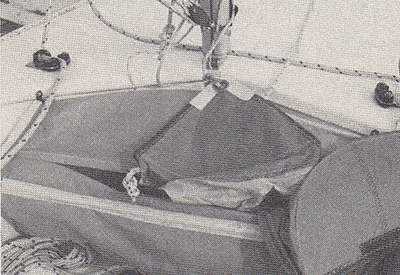 It seems to me that the trapeze is what makes the boat distinctive, so more attention should have been given to the trapeze gear – especially as this will be a first introduction to traipsing for thousands of new sailors. Though cost of fittings on small boats is what can really knock the price out of line, and though performance has kept its reputation for supplying the best possible quality at a reachable price, a little extravagance on the trapeze wire would have earned a higher score.
It seems to me that the trapeze is what makes the boat distinctive, so more attention should have been given to the trapeze gear – especially as this will be a first introduction to traipsing for thousands of new sailors. Though cost of fittings on small boats is what can really knock the price out of line, and though performance has kept its reputation for supplying the best possible quality at a reachable price, a little extravagance on the trapeze wire would have earned a higher score.
Having discovered what we didn’t like on the upwind leg (and that’s where it tends to show up) we laid off and prepared to indulge ourselves in what we had really gone out there for: blasting across the bay with the chute up.
With enviable speed and precision, Jay had the spinnaker out of the bag and pulling while I had enough time to get myself rearranged in the cockpit. You can see from the photographs that once you get inside the boat there’s not much room to spare, especially for someone of my height, (nearly 6 ft 3 in). I found generally that everything was confined and whether I was feeling for the windward straps (I used the leeward) or balancing in the cockpit while the spinnaker was going up, I wanted to be a few sizes smaller. Performance Sailcraft is careful to emphasize in its sales literature that the weight tolerance is wide – from 230 to 400 lb. I question whether 400 lbs is realistic. We probably weighed in at 325 lbs and we certainly never felt we needed more. In fact, several pounds less (especially in my position) would have been faster, even upwind.
Once that chute popped, however, it was hard to imagine going any faster. The Laser 2 is blessed with that all out screaming speed that brings a lump to your throat and a dumb grin to your lips. It also brings stinging spray to face, but what price pleasure?
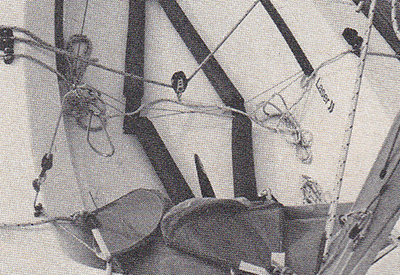 This is where trapeze talent really starts to pay off. With Jay’s energetic work on the wire and his good natured coaching, we kept the pressure up and blasted through the soft spots by hardening up as the wind faltered and steering down, to get the hull back under the rig, when we got a gust. This is nothing new to anyone who’s sailed a fast planing boat but it’s unknown outside of that small group. When a keelboat sailor tells you that his So-and-so 27 sails “just like a big dinghy,” don’t even try to explain. This is a kind of sailing that’s altogether different and is some of the most exciting and challenging sailing you can do. The Laser 2 is designed to do it well.
This is where trapeze talent really starts to pay off. With Jay’s energetic work on the wire and his good natured coaching, we kept the pressure up and blasted through the soft spots by hardening up as the wind faltered and steering down, to get the hull back under the rig, when we got a gust. This is nothing new to anyone who’s sailed a fast planing boat but it’s unknown outside of that small group. When a keelboat sailor tells you that his So-and-so 27 sails “just like a big dinghy,” don’t even try to explain. This is a kind of sailing that’s altogether different and is some of the most exciting and challenging sailing you can do. The Laser 2 is designed to do it well.
Naturally, sail area is the key to it. With 125 ft2, Laser 2 has 49 ft2 more than a Laser on a longer and slightly heavier hull. For comparison – the 420 carries 111 ft2 on a heavier, shorter hull.
To use that power, all but the heaviest crews will need the trapeze.
Hull design is important here too. Laser 2 does look like a Laser but there are essential differences. The width of
the flat sections is greater than on a Laser hull and the topsides are near vertical. Even though the Laser 2’s beam is not excessive, the waterline beam is extra wide. It’s a hull that’s at its best on a plane and will have to be sailed dead level off a plane or on.
There’s no question it’s wet – and we were sailing in protected water. The shallow cockpit doesn’t retain much but what does stay after the dowsing takes its time draining out. The self-bailer is set in the middle of the aft end of the cockpit and unless the boat is level it’s ineffective. Most of the water, of course, leaves via the daggerboard slot which is flush with the cockpit sole.
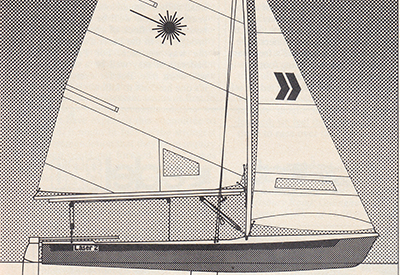 With its Australian antecedents (more on that later), the Laser 2’s spinnaker is unusual and extremely effective. The pole extends about three feet beyond the forestay and the spinnaker is cut with a long foot and short leeches; it can be carried close to the wind easily. That’s handy, since your apparent wind changes suddenly with acceleration and steering for balance. I’m guessing here but, for the same area, it probably cuts the load on the trimmer. Pole angle has relatively more effect on the shape of the spinnaker but, more importantly, spinnaker sheets lead quite comfortably to the middle rather than to the back of the boat, obviating the need for extra turning blocks, extra sheet length and tangles with the helmsman. The whole spinnaker setup is sensible and well executed. The pole stows along the boom with lift attached and the spinnaker stuffs into a proper launching bag.
With its Australian antecedents (more on that later), the Laser 2’s spinnaker is unusual and extremely effective. The pole extends about three feet beyond the forestay and the spinnaker is cut with a long foot and short leeches; it can be carried close to the wind easily. That’s handy, since your apparent wind changes suddenly with acceleration and steering for balance. I’m guessing here but, for the same area, it probably cuts the load on the trimmer. Pole angle has relatively more effect on the shape of the spinnaker but, more importantly, spinnaker sheets lead quite comfortably to the middle rather than to the back of the boat, obviating the need for extra turning blocks, extra sheet length and tangles with the helmsman. The whole spinnaker setup is sensible and well executed. The pole stows along the boom with lift attached and the spinnaker stuffs into a proper launching bag.
It was during the jibes that I began to appreciate the boat’s stability. This was apparently a design factor from the beginning since North Americans like to be able to tie their boats to a dock and leave them unattended – something you can’t do with a Taser. The Laser 2’s stability will be a bonus for sailing schools. It allows you to make a few foul-ups without getting wet. It also allows complete beginners to just throw up their hands and let everything go (provided no one is on the wire) without suffering the penalty meted out by more sensitive boats like flipping to weather.
We didn’t have the opportunity to sail the boat in anything but a heavy breeze but I’ll speculate on light air performance. With the high wetted surface inherent in the design of the large flat sections, the Laser 2 makes some sacrifice in light-air speed. More importantly, however, the size of the cockpit and the fairly basic approach taken toward the fittings and sail controls will make light air racing awkward for adult crews.
Downwind, the forward hand will have to contend with a half-raised daggerboard.
Any boat that has to be taken out of the water and transported to regattas, as this one will be, has to perform handily ashore too. In keeping the size and weight down, the designers have made car-topping a possibility.
Rigging and unrigging will seem like a chore to a Laser sailor but it’s about as simple as a boat with shrouds can be. Doing without the shrouds would just not produce a fast boat; even as it is, forestay tension may be attained by some unusual means.
The mast breaks into two sect ions and all the halyards can be left in place, making a package that is the same length as the hull. Incidentally, performance on the water and on the car roof are not the only considerations in today’s world of international boat business. The dimensions of shipping container s have a lot to do with the Laser 2’s freeboard and length – an interesting footnote in the history of sailboat design.
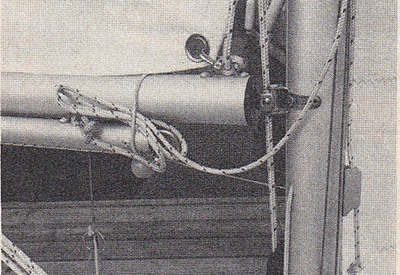 In fact, the Laser is expected to sell all over the world and I can’t see why it won’t. The North American school and college market is an obvious target, as are those who’ll be the next generation of racers, now cutting their teeth in Optimist prams all over Europe.
In fact, the Laser is expected to sell all over the world and I can’t see why it won’t. The North American school and college market is an obvious target, as are those who’ll be the next generation of racers, now cutting their teeth in Optimist prams all over Europe.
Frank Bethwaite, the unclaimed maestro of high-powered dinghy design, and Ian Bruce, the designer / promoter of Performance Sailcraft, may have come up with the only boat that could live up to the expectations created by the Laser. It doesn’t bring anything startlingly new to sailboat design except perhaps the idea that a mass-market boat should be fast and challenging. It will appeal to the gung-ho coastal sailors of Australia where Bethwaite works and to the throw-it-in-and-get-going cottage and youth market that has been developed all over North America. In Europe, where there are more choices in that size as well as better developed fleets of similar types, it may not sell as well. We’ll undoubtedly see them everywhere, though, and it will become (as the Laser has become) everyone ‘s idea of what a small sailboat should look like. Not many years from now we’ll be reading about how the new flock of champion sailors brought up in the Laser 2’s is changing the way we race. For Performance Sailcraft , it may well be a return to a well-worn role. But for everyone else, it’s one hard act to follow.
Originally published in Canadian Yachting’s February 1980 issue.
Specifications:
LOA – 14ft 5in
Bmax – 4 ft 8 in.
SA – 124 sq ft
SA (spinnaker) 110 sq ft
Weight – 160 lbs
Photo Captions:
Photo 1 – Under Sail
Photo 2 – Profile
Photo 3 – Everything about the spinnaker gear is sensible including the launch bag.
Photo 4 – The cockpit looks different full of legs – it could be small for adults.
Photo 5 – Size and Weight make car-topping possible.
Photo 6 – Controls have been simple and fittings light. Shape control is basic.






















